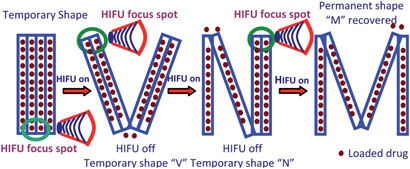Scientists from China and Canada have found that a drug-loaded shape memory polymer can be manipulated by ultrasound and that they can control when and how the drugs are released.
Shape memory polymers (SMPs) can be deformed and fixed into a temporary shape and then recover their original permanent shape under external stimuli such as heat, explains lead researcher Hesheng Xia from Sichuan University, Chengdu. ‘When a piece of polymer is placed in the body, it is subjected to heating at 37°C everywhere and the whole piece undergoes shape recovery,’ he says. Xia and co-workers directed an ultrasound beam on a selected area of a polymer, causing a local rise in temperature and triggering shape recovery only in that area. Xia adds that ultrasound has the advantage of easily penetrating body tissue.

Using high intensity focused ultrasound (HIFU), the polymer was changed from its permanent M shape to a temporary I shape, then a V then an N and back to the M, releasing drugs with each change
Xia’s group loaded their SMP sample with a drug and folded it into a temporary ‘I’ shape. By directing the ultrasound onto different positions on the polymer, they could control its shape on demand, changing it from ‘I’ to ‘V’ to ‘N’ and back to the original ‘M’, releasing drugs with each shape change. They stopped the drug release by switching off the ultrasound. This caused a quick temperature drop, which allowed the polymer to adopt a stable intermediate shape.
Tao Xie, who works on shape memory polymers at the General Motors Research and Development Center, Michigan, US, was impressed that ultrasound controls the shape in a spatial and temporal manner, allowing selected regions of the polymer to be controlled on demand. He added that this would ‘significantly widen the application potential’.
Xia hopes that the switchable release of drugs from SMPs could be applied to polymer implants for minimally invasive surgery and that ultrasound may reduce infection risks. To minimise side effects, however, he says that the challenge will be to reduce the power and irradiation time of the ultrasound needed for the shape changes.
Spatial and temporal control of shape memory polymers and simultaneous drug release using high intensity focused ultrasound
Guo Li , Guoxia Fei , Hesheng Xia , Jianjun Han and Yue Zhao
DOI: 10.1039/C2JM30848G
Read the original Chemistry World article here










